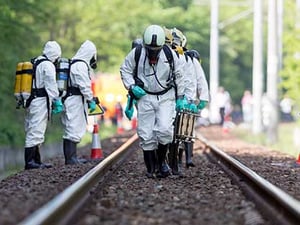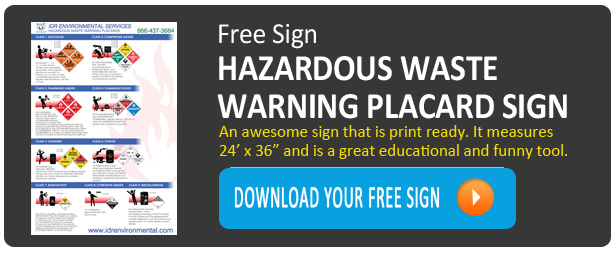Hazmat stands for “hazardous materials,” which refers to substances or materials that possess the potential to cause harm to people, animals, property or the environment. These materials are considered hazardous due to their chemical, physical or biological nature, and can be in various forms, such as solids, liquids, gasses or even mixtures of substances.
Hazmat items can range from common household chemicals to industrial materials, and they require special handling, storage, transportation and disposal methods to prevent accidents, spills or contamination that could lead to health hazards, fires, explosions or environmental damage.
Various government agencies regulate the classification and handling of hazardous materials, and guidelines are in place to ensure their safe management.
If your company or institution handles hazardous materials, it’s critical to grasp the potential risks associated with these substances fully and to have a comprehensive understanding of the proper protocols for their safe handling, storage, transportation, and, ultimately, disposal.
Hazmat Components
Hazmat encompasses a broad spectrum of substances distinguished by their chemical, physical or biological.png?width=300&height=251&name=Untitled%20design%20(70).png) properties, each possessing the potential to cause harm to human health or environmental health.
properties, each possessing the potential to cause harm to human health or environmental health.
Chemical compositions of hazmat vary widely but generally are corrosive, reactive, flammable or toxic.
- Corrosive susbtances have the ability to chemically erode or disintegrate materials upon contact, posing severe damage to surfaces, skin or living tissues. Examples of corrosive substances include hydrochloric acids and sodium hydroxide.
- Reactive materials are prone to rapid chemical reactions when exposed to specific conditions or substances, potentially leading to explosions, fires or the release of hazardous byproducts. Examples of reactive materials include potassium metal and nitric acid.
- Flammable materials possess the capability to ignite and burn in the presence of an ignition source, contributing to fire hazards and endangering surrounding environments or individuals. Examples of flammable materials include gasoline and propane.
- Toxic substances have the potential to cause harm or illness to living organisms through inhalation, ingestion or skin contact, often requiring specialized handling and safety precautions to prevent health risks. Examples of toxic substances include mercury and cyanide compounds.
Certain hazardous materials incorporate biological agents or substances that can be harmful to living organisms, amplifying the complexity of their management and necessitating distinct safety protocols. Examples of biological agents include:
- Biological toxins like neurotoxins and ricin
- Infectious agents like anthrax and ebola
- Biological agents for research or medicine, like genetically modified organisms or live viruses
Understanding the diverse forms and characteristics of these hazardous materials is essential for ensuring their proper management to prevent potential hazards and mitigate risks associated with their use, storage, transportation and disposal.
Hazards Associated With Hazmat
Hazardous materials present significant health risks to individuals exposed to them, though these risks vary based on the nature of the material.
For example, exposure to corrosive substances like strong acids or bases can cause severe burns or tissue damage upon contact with the skin or eyes. Toxic materials like certain chemicals or biological agents can lead to poisoning, respiratory problems or long-term health issues if inhaled, ingested or absorbed through the skin.
Substances like biological toxins or infectious agents can cause severe illnesses or even fatalities if appropriate precautions are not taken.
Hazmat also poses substantial risks to the environment when improperly handled or disposed of. Spills or leaks of hazardous liquids or gasses can contaminate soil, water bodies and the atmosphere. Chemical pollutants or toxins can negatively impact ecosystems, harming plant and animal life, disrupting habitats and contaminating food chains. Improper disposal of hazardous waste can lead to long-term environmental degradation, affecting natural resources and compromising the overall ecological balance.
Look through news archives and you’ll likely find several examples of hazmat incidents, which can encompass a wide range of scenarios. Accidents during transportation, mishandling in storage facilities, leaks or spills during industrial processes, or deliberate acts involving hazardous materials are all examples of hazmat incidents.
These incidents have the potential to result in fires, explosions, chemical releases or contamination events. These occurrences can endanger lives, cause extensive property damage, lead to evacuations and require complex cleanup and mitigation efforts.
Understanding and mitigating these hazards associated with hazmat are essential to implementing preventive measures, emergency response protocols and stringent regulations to minimize the likelihood of hazmat incidents.
Hazmat Placards
Specialized hazmat placards play a pivotal role in identifying and communicating the nature of contained hazards. These placards simplify the identification of hazards using colors, symbols and numerical codes. They follow guidelines established by various regulatory bodies in the United States and worldwide, including the Department of Transportation (DOT) and the International Maritime Organization (IMO).
There are nine classes of hazmat placards:
Explosives (Class 1)
Class 1 placards indicate the presence of explosives. This category is divided into six divisions that help identify the type of explosive, such as a mass explosion or a non-mass explosive with a projection hazard. These placards typically feature a prominent orange background with a black explosion symbol in the center. Examples of dangerous goods falling under this category include dynamite, fireworks, ammunition and blasting caps.
Gasses (Class 2)
Placards in this category identify materials that are gasses, including flammable gasses, non-flammable gasses and toxic gasses. Placards in this category are primarily color-coded with green, red or yellow backgrounds and may include symbols representing specific gas properties. Examples of substances falling under this category include propane (flammable gas), nitrogen (non-flammable gas) and chlorine (toxic gas).
Flammable Liquids (Class 3)
Flammable liquids placards represent highly flammable materials that pose a fire hazard. These placards feature a red background with a symbol indicating flames. They also indicate more details about the substance, including whether it is gasoline, combustible or fuel oil. Examples of substances falling under this category include gasoline, ethanol and acetone.
background with a symbol indicating flames. They also indicate more details about the substance, including whether it is gasoline, combustible or fuel oil. Examples of substances falling under this category include gasoline, ethanol and acetone.
Flammable Solids (Class 4)
Placards in Class 4 represent materials that are easily ignited. They typically feature a flame symbol, though the color may vary. Spontaneously combustible substances will feature a half-red and half-white background, while flammable solids feature red and white stripes. Substances that are dangerous when wet feature a blue background. Examples of substances falling under this category include matches, alkali metals, metal powders, calcium carbide, and sodium batteries and cells.
Oxidizers And Organic Peroxides (Class 5)
Class 5 placards are used for materials that release oxygen or are capable of causing or contributing to combustion. These placards often have a yellow background with an oxygen symbol, though organic peroxide features a half-red, half-yellow background. Examples of substances falling under this category include hydrogen peroxide (oxidizer) and tert-butyl hydroperoxide (organic peroxide).
Poisonous And Toxic Materials (Class 6)
Placards in this category indicate materials that are poisonous or toxic if inhaled, ingested or absorbed through the skin. Placards in this category are usually white with a skull and crossbones symbol. Examples of substances falling under this category include hydrogen cyanide (poisonous gas), arsenic (toxic solid) and chlorine gas (toxic gas).
Radioactive Materials (Class 7)
These placards are used for materials that emit ionizing radiation. These placards are typically yellow and white with a radiation symbol. Examples of substances falling under this category include uranium, cobalt-60, and medical isotopes used in nuclear medicine.
Corrosive Materials (Class 8)
Placards in Class 8 identify materials that cause severe damage to skin, eyes or other materials they come into contact with. Placards in this class are typically white with a black corrosion symbol. Examples of substances falling under this category include sulfuric acid, sodium hydroxide (caustic soda) and hydrochloric acid.
Miscellaneous Hazardous Materials (Class 9)
This category is used for materials that do not fit into the other classes but still pose a hazard during transportation. One of this category's most frequently used designs is a white background with black and white stripes in the top corner. Examples of substances falling under this category include asbestos, dry ice and lithium batteries.
The Role Of A Hazmat Disposal Company
Hazardous waste disposal companies serve a critical role in assisting businesses with the management, handling and proper disposal of hazardous materials. These companies are equipped with the expertise, specialized equipment and regulatory knowledge necessary to handle various types of hazardous waste, ensuring compliance with stringent environmental and safety regulations.
handling and proper disposal of hazardous materials. These companies are equipped with the expertise, specialized equipment and regulatory knowledge necessary to handle various types of hazardous waste, ensuring compliance with stringent environmental and safety regulations.
Identifying And Classifying Waste
Disposal companies aid businesses in identifying and classifying hazardous materials generated during their operations. They assist in determining the nature of these materials, whether they are corrosive, toxic, reactive or flammable, and the appropriate procedures required for their safe disposal.
Guidance On Containment
Hazard waste disposal companies also offer guidance on the proper containment, storage and transportation of these materials. They provide suitable containers and packaging to ensure the secure handling and transport of hazardous waste, minimizing the risk of leaks, spills or contamination during transit.
Oversee Disposal Process
Disposal companies have access to specialized facilities, such as treatment plants, incinerators or recycling centers, designed to handle and process hazardous waste in an environmentally responsible manner. This includes treatments to neutralize, detoxify or recycle hazardous substances, reducing their environmental impact.
Prioritize Compliance
Hazardous waste disposal companies maintain a strong emphasis on compliance with local, state and federal regulations governing the proper disposal of hazardous materials. They keep abreast of evolving regulations, ensuring that businesses adhere to legal requirements regarding waste handling, transportation and disposal, thus shielding companies from potential regulatory penalties and liabilities.
Respond To Hazmat Situations
Hazardous waste disposal companies play a pivotal role in responding to hazardous material incidents and accidents. Upon notification of a hazmat incident, these specialized companies dispatch trained response teams equipped with appropriate personal protective gear, containment tools and specialized cleanup equipment to the scene.
Their initial priority is to assess the situation, identifying the type of hazardous material involved and evaluating the potential risks to human health, the environment and property. Employing established protocols and safety procedures, hazmat teams work to contain and mitigate the spread of the hazardous substance, minimizing further exposure and damage.
They utilize containment barriers, absorbents and specialized tools to manage spills or leaks, aiming to prevent the material from spreading and causing additional harm. Hazmat response teams also coordinate closely with local authorities, emergency services and regulatory agencies to ensure a well-coordinated and effective response, while maintaining a focus on safeguarding public safety and minimizing the environmental impact of the incident.
Training And Preparedness
Disposal companies conduct rigorous training programs for their response teams, ensuring they are well-prepared to handle a wide range of hazmat incidents. Regular drills and simulations help these teams maintain readiness to respond promptly and effectively in high-stress situations, enhancing their ability to contain and manage hazardous materials during emergencies.
The best disposal companies will also work with your business to ensure your employees are trained in safety protocols and handling hazardous materials. Look for a waste partner that offers a hazardous waste walk-through program, which is a great way to evaluate your training needs.
By partnering with hazardous waste disposal companies, businesses can focus on their core operations while entrusting the complex and critical task of managing hazardous materials to specialized professionals. This collaboration not only ensures the safe and compliant disposal of hazardous waste but also contributes significantly to environmental protection and public safety.



Comment